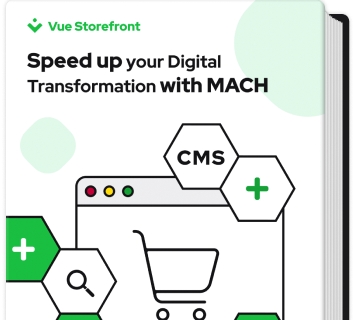Explore by Category:
eCommerce
In today's digital age, personalization has become critical for businesses to attract and retain customers. With multiple touchpoints on the customer journey and a complicated competitive landscape, personalization is one of the top things retailers are ready to invest in this year.
For years personalization has been about one piece of content following users all across the Internet; now, retailers aim for a more Spotify-like experience. Retail's ultimate goal is to get users to want the service to know more about them and their preferences.
This is a more dire task than creating an algorithm that would show green clothes to a person who once bought green pants from an online store. So how can retailers tackle this challenge?
To answer this question, MACH Haus NY 2023 gathered an expert panel of personalization at one of their meetings, including Alokai. Read on for the best practices for personalizing your customers' experience!
Have a personalization strategy
The beauty of MACH architecture is its almost endless possibilities for personalization. With the API-based composable approach, the companies are no longer stuck with only one monolithic solution and can opt for any new technology on the market. But this is also MACH's biggest trap, since it's easy to get carried away by tech.
Fight the temptation of getting obsessed with technology and instead focus on customer experience first.
— Tyson Graham, Head of Enterprise sales (Americas), Alokai
To leverage personalization, retailers need a strategy that allows them to implement solutions gradually and evaluate the value that every technology brings to the customers. Such a strategy helps understand how technologies work together and what results they bring.
Personalization is not a one-size-fits-all solution. First, companies must identify the highest-impact areas where personalization can make the most significant difference in customer experience. Then, by gradually testing theories and approaches, retailers gain feedback that they can later use to optimize their campaigns.
Define success and goals
What success means in terms of campaign results differs from company to company. It depends a lot on retailers' goals when they start working on personalization. However, as the definition of done is a core component of Agile, the definition of success is one of the cornerstones of the MACH personalization campaign.
Composable architecture is the most customer-centric architecture: it allows you to pull in the most innovative services while keeping the experience intact.
— Tyson Graham, Head of Enterprise sales (Americas), Alokai
Some companies define success as growing conversion rates. Others operate in terms of revenue, and as long as revenue numbers grow, the number of sales is less significant. Still others are launching new strategic categories and aiming at sales within them rather than an overall conversion rate.
All three cases have different approaches and metrics to evaluate whether the campaign works. Combine defined expectations with testing and clever use of MACH technologies in the composable stack.
Put personalization where it matters and test it out
Personalization for the sake of personalization won't bring companies the desired outcome. The changes that create meaningful and relevant customer experiences often come hand in hand with trial and error.
If you do personalization well, it's seamless.
— Dan Martino, VP at TA.Digital
It's an ongoing process, not a one-time project. That's why testing and measuring are crucial to identifying whether personalization is in the right place and working.
Even obvious theories need to be put to the test. For example, it seems logical to put the item a person bought before on top of their search when they browse for similar things. However, the A/B testing held by Constructor.ai showed that casual browsers don't want to see what they bought last time, and this personalization tactic doesn't bear fruit.
MACH architecture allows retailers to test the theories by bringing a particular technology in and swiftly taking it out in case of failure. It makes failed tests a lesson rather than a risk and provides data companies can feed back to the system and optimize it.
Utilize the customer data
Data is the foundation of personalization campaigns. With MACH architecture done right, companies can use the customer data gathered from different channels to tailor experiences to individual customers' unique needs and preferences.
I don't think that nearly enough companies ask users for explicit feedback. If I am a gluten-free shopper, I want my grocery store to know that. I wish they would've just asked me.
— Eli Finkelshteyn, CEO at Constructor.ai
Quizzes, surveys, and other ways of feedback exchange bring crucial data to retailers. Despite the tension between privacy and what customers want in terms of personalized content, creating a more customized digital space benefits both sides.
The strategy comes in handy when choosing the data to base personalization on. APIs provide a flexible enough structure to gain information from various sources and distribute the personalized content later to the endpoints. But instead of putting together all the customer data at once, start with one channel that aligns with the strategy best.
Tailor your content model
Fast-scaling personalization has its own limiting factors. One of them is content. As singular buying personas become multiple and more detailed individual customers, companies have to produce more content and distribute it faster across channels.
We're transitioning from personas-driven content to a personalized experience.
— Alan Anderson, Digital Transformation Director at Kontent.ai
Choosing a suitable content model is an essential key to success. In this case, smaller composable pieces of content that can be easily rearranged and combined to create personalized experiences work better than longer, more stable forms.
A modular approach gives retailers granular control over how content is displayed and personalized across different touchpoints. Combined with learning systems around content and images and the automation that comes with it, it makes content creation and personalization much faster at a bigger scale.
To sum up
MACH architecture is very customer-centric and offers many tools for personalization. To get the enhanced customer experience retailers hope for, they have to know what business problems they're solving and streamline their efforts.
Watch the full recording of the "Best Practices for Personalization" session at MACH Haus NY 2023:
Share:
Share:
More in eCommerce
Ready to dive in? Schedule a demo
Get a live, personalised demo with one of our awesome product specialists.






















